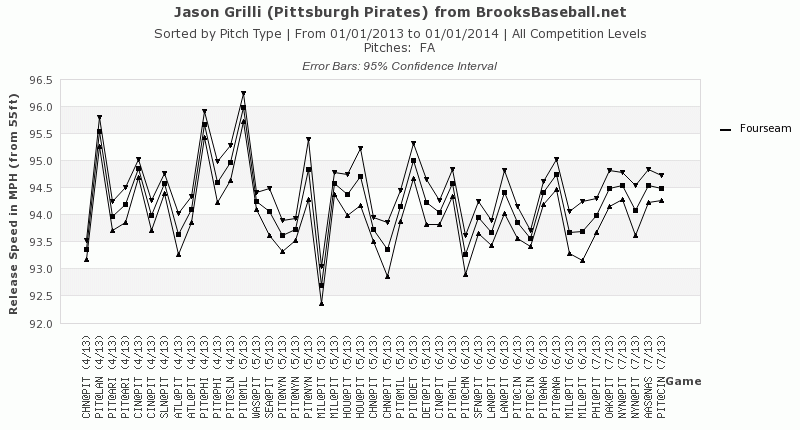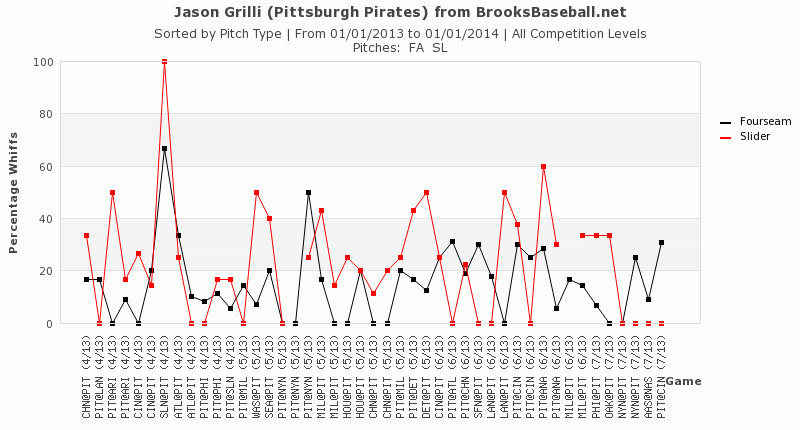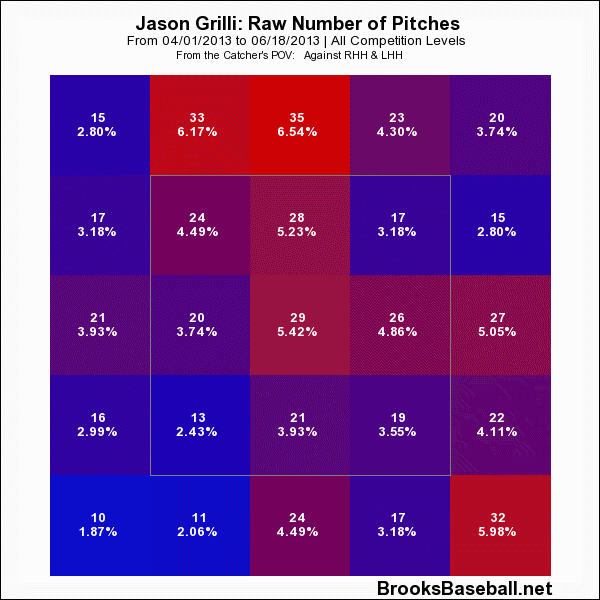After Jason Grilli served up his home run to Jayson Werth last night, my immediate thought was that the first thing I wanted to do after the game ended was to dig through his profile on Brooks' Baseball to see if I could find a reason for his recent struggles. On June 18th, Grilli struck out the side against the Reds with a 4-0 lead. To that point, Grilli had 34 appearances and 31 2/3 innings pitched; he struck out 54 hitters, walked seven, gave up zero home runs, and scattered three runs and 17 hits across those 31 2/3. On June 19th, Grilli gave up a solo home run to Jay Bruce with a 1-0 lead to blow his only save of 2013. Starting with that game, Grilli's given up eight runs in 11 appearances. In his 10 2/3 innings, he's struck out 11, walked three, given up 12 hits, and three homers.
My initial reaction to Grilli's struggles (back around the time of this ugly outing against the Angels and in the aftermath of it) was that they weren't much to worry about. Grilli isn't a groundball pitcher; he wasn't going to go through an entire season without giving up a home run. His control seemed OK, his strikeout and walk numbers were not as good as before but still pretty decent, and I couldn't see any change in his fastball velocity. Going back over the data, that's more or less true. As it turns out Grilli's velocity dipped in the immediate aftermath of that terrible game against the Angels before creeping back up to about where it was before the bad outing. This chart shows Grilli's average velocity for every 2013 appearance (note: none of these graphs below will have Monday's game, because I'm writing this before the results will be deposited in the Brooks database):

These charts and graphs are all from Brooks Baseball; here's the link to Grilli's Brooks' page, where I encourage you to waste your morning clicking around making your own charts and graphs of Grilli's work this year
The middle line is his average velocity; the top and bottom lines are error bars for a 95% confidence interval. You can see that the confidence interval isn't quite as tight in the last month. Basically, Grilli's fastballs have had a wider range of velocities in the last month or so than they did earlier in the year (think of it this way; ten pitches thrown at 95 mph will average 95 mph, but so will five pitches thrown at 100 mph and five pitches thrown at 90 mph). I have no idea if this means anything at all, but I'm mentioning it because it's something that I noticed right away.
If Grilli's fastball isn't the glaring problem, there's only one other place to look. Grilli's strikeouts have been down lately, and it's because hitters have stopped chasing his slider. Here's the whiff percentage for all of his appearances this year, with his fastball in black and his slider in red. Check out what happens to the slider in his most recent apperances.

Before Monday's game, Grilli went four straight appearance (including the All-Star Game) without getting a swinging strike with his slider. That's noticeable, but it's also not indicative of an injury. He could be tipping his pitches. It could be that hitters have a better book on him as the season wears on. It could be nothing at all, since there are eight other games in which he threw a slider but didn't induce a swinging strike with it. Still, everything that we've seen so far indicates that if there's been something wrong with Grilli since mid-June, it's something to do with his slider. Let's start with horizontal movement, broken down by start.

That looks relatively consistent to my eyes. Vertical movement?

Again, I don't think there's much to see here. You could probably tell yourself that there's an ebb and flow to the vertical break of Grilli's slider as the season's worn on and that it's been unpredictable since the June 19th blown save against the Reds (which is the big spike 3/4 of the way along the chart), but I think that that's more likely just trying to see something for the sake of seeing something.
We could do release points, too, but there's not much to see there, either. Grilli's horizontal release point looked really weird in Anaheim, but his vertical release point seemed fine. That could mean a camera problem, that could mean he stood at a slightly different point on the rubber, but I don't think that it means anything terribly major. The point of all of this is that there's not one glaring red flag that I can find (and it's possible I'm missing it here) that screams to me that Grilli's been deteriorating or pitching hurt since his struggles started in mid-June.
Really, it seems like Grilli's problems have been as simple as failing to locate. You can explore this for yourself, but Grilli's strategy this year has basically been "fastballs up/sliders down." Because Grilli's slider is such an excellent pitch, that's kept hitters off balance. This is his pitch-location heat-map from April 1 to June 18th:

You can see that Grilli exists almost entirely outside of the strike zone; he pounds his fastballs in above the strike zone, then he drops the slider out of it. As anyone that's tried (and failed) to blow a high fastball past a hitter can tell you; that's an incredibly thin line to walk. Here's the same heat map for Grilli since June 19:

Look at the red in the top half of the strike zone. Specifically, look at the three squares that make up the top of the strike zone, compared with the three squares directly above it. In the first part of the season, Grilli was regularly getting his fastball up and out of the strike zone. Since June, he's left it down in the top part of the strike zone almost as much as he's gotten it up and out of the zone. There's a bit more red to the left and right of the strike zone in the second chart. Since that's not how Grilli pitches, I'd read that as him missing his spots a little more regularly. You can see where he's missing and relate this back to the low whiff-rate on his slider; if he's not placing his fastball as well as in the first part of the season, hitters probably aren't as likely to go fishing for that low-and-away slider.
Still, if you were going back and combing through the data and looking for a bright red flag saying, "Jason Grilli hurt his arm on this date and he's been deteriorating since then," I'm not sure that I see one. There are a million reasons a pitcher could miss his spots over a month-long slump; an injury looming under the surface is one reason for that, sure, but it could also be general fatigue (Grilli's certainly pitched more in relief this year than any year in his past), or that his mechanics got a bit sloppy as the year went on or whatever.
I suppose that the silver lining here is that if Grilli's injury isn't serious, there's nothing here that indicates to me that he can't get back on track whenever it is that he returns to the mound. The Pirates have a number of things to consider over the next week depending on Grilli's health (they do have internal relief options in Triple-A, but then there's also the trade deadline in eight days to consider), but I think we might as well wait until we know more about Grilli's arm before doing a bunch of speculating on that front.




















